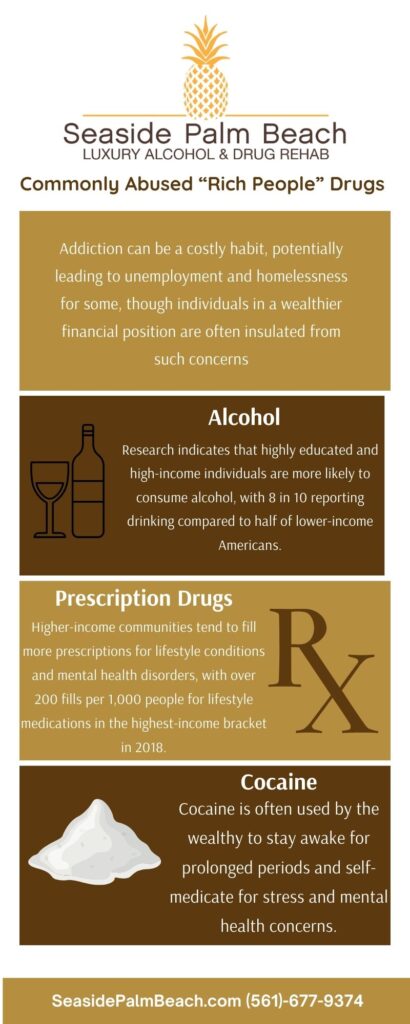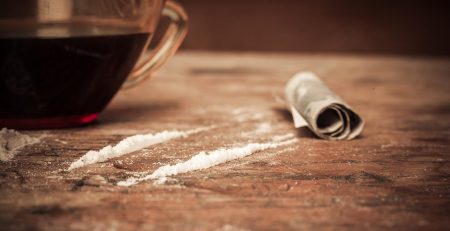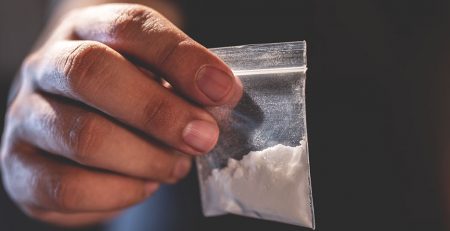While certain drugs are considered to be “affordable,” addiction is a generally expensive habit. While this can cause some to venture into unemployment and homelessness, those in a wealthier financial state often don’t have to worry about that. While movies like Wolf of Wall Street, Scarface, and Blow glamorized substance abuse, they also portrayed the many “rich people drugs” common to those in high-income job fields. Our luxury drug and alcohol rehab in South Florida is looking into substance abuse among the wealthy and the drugs most commonly used by the upper class.
Commonly Abused Upper-Class Drugs
Is drug use among the rich as outrageous as it’s portrayed in the media? Are executives snorting lines of cocaine in their offices, like Wolf of Wall Street? Does every other Amex card have a white powdery substance between its numbers? Or are corporate bankers just microdosing LSD and mushrooms to make the days seem shorter?
While many of us have dreaded waking up and looking at our bank accounts, people making six figures or more usually don’t have this struggle. Although we often say we believe that money would make life easier, sometimes it makes people more reckless. With this in mind, our luxury Seaside rehab decided to look into the use of drugs by income and “rich people” drugs typical among the wealthy.
Alcohol
According to research, people who are highly educated and have a high income are more likely than other Americans to drink alcohol. While 8 in 10 Americans of a high socioeconomic status say they drink, only about half of lower-income Americans say they drink. Additionally, more than 80% of college graduates reported that they drank, compared to less than 52% of those who had a high-school education or less.1
Drinking patterns also vary by income and education. For instance, nearly half of the higher-income and educated drinkers said they had a drink within the last 24 hours in one survey, compared with one-third or less of non-college graduates and middle or lower-income drinkers. These differences are especially obvious when it comes to income. Almost half of the upper-income drinkers, 47%, said they drank in the last 24 hours, compared with 18% of lower-income drinkers.1
High-income Americans not only have greater economic resources, meaning they have the money to buy as much alcohol as they want. However, they’re also more likely to participate in activities and move in social circles that involve drinking, such as dining out at restaurants, going to clubs, and going on vacation. This connection could also explain why alcohol is one of the most common rich-people drugs.
Prescription Drugs
According to an analysis by GoodRx, higher-income communities fill more prescriptions for lifestyle conditions and mental health disorders than low-income communities. Lifestyle conditions include acne, erectile dysfunction, excessive sweating, eyelash growth, facial wrinkles, hair loss, hyperkeratosis, rosacea, and skin discoloration. In 2018 alone, there were over 200 fills per 1,000 people for lifestyle medications in the highest-income bracket (90 percentile or higher).2
Mental health medications – such as those used to treat ADHD, alcohol addiction, anxiety, bipolar disorder, depression, eating disorders, fatigue, obsessive-compulsive disorder, and panic disorder – are more popular in high-income areas. There were more than 1,500 fills per 1,000 people filled for mental health medications in 2018.2
However, highly addictive medications – such as opioids – are not found to be more common among the wealthy. Despite the ongoing opioid epidemic, the misuse of illegal opioids (like heroin) or prescription opioids is highest among the poor and continues to affect those living in poverty at disproportionate rates. In fact, according to the Centers for Disease Control and Prevention (CDC), heroin use is highest among individuals who make an annual income of less than $20,000, and second highest is $20,000 to $49,000, as opposed to those who make $50,000 or more per year.3
Cocaine
Although cocaine made its entrance into the U.S. via low-income neighborhoods in the 1980s, it quickly became a commonly abused drug among celebrities, stuntmen, and other prominent figures in Hollywood. This became apparent starting with Robert Lindsey’s front-page story “Pervasive Use of Cocaine Is Reported in Hollywood,” which appeared in The New York Times on October 31, 1982.4
The story described how drug use had become so popular that companies insuring movies had begun to amend their policies to reflect drug-related dangers. Lindsey quoted an unpublished survey of stuntwomen that claimed more than half of the women actively used drugs or knew someone who did.5
Medical professionals interviewed by The New York Times also recounted their clients’ drug behaviors. For instance, Dr. Ronald Siegel, a psychopharmacologist treating patients in Hollywood, said that “cocaine generally does not impair the work or family life of users.” Some users were spending “$2,000 to $12,000 a week,” he said, and it was “not unusual for someone to spend $500,000 to a million dollars a year on cocaine.”4
Doctors who were interviewed for the article also said that the drug generally appealed to women under the age of 35 with busy schedules and demanding jobs. Sociologist Arnold Washton argued that “more women in male domains, in medicine, in banking, in law … become targets for cocaine use.” These women, he explained, were often “juggling being a wife and mother with performing on the job.”5
Although crack eventually became so affordable that it gained popularity among those in the lowest-income bracket, it remains one of the most common rich people drugs among executives and individuals making at least six figures. With the ability to keep even the most exhausted stay-at-home mom awake and moving, cocaine is often used by the upper class to counteract the effects of more sedative substances like alcohol. It also allows individuals with busy schedules to stay awake for long periods and is used to self-medicate stress and other mental health problems, which are among the most common reasons why rich people do drugs.
As a luxury drug and alcohol rehab in Palm Beach, we’ve helped numerous high-income individuals privately and effectively recover from addiction. With special amenities like private transportation and high-end single-living spaces, we can offer you or a loved one safe and effective luxury detox and addiction treatment that lives up to your standards of comfort.
Get Luxury Addiction Treatment Today
It’s no secret that among the rich, drug use is quite common. No matter what your background is like or what type of drug addiction you’re battling, our facility can help.
For more information about our addiction treatment in Palm Beach, call Seaside Palm Beach today at 561-677-9374. Or you can send us your contact information, and one of our admission specialists will reach out to you.
Sources:
- GALLUP – Alcohol and Drinking
- GoodRx – The Effect of Income on U.S. Prescription Fill Patterns
- CDC – Today’s Heroin Epidemic Infographics
- The New York Times – Pervasive Use Of Cocaine Is Reported In Hollywood
- Points History – Cocaine in 1980s America: Fine for the Wealthy & Well-Educated; Bad for the Poor














